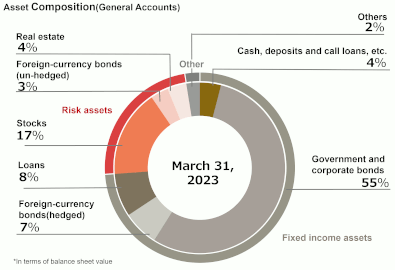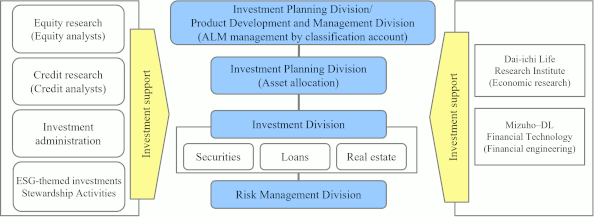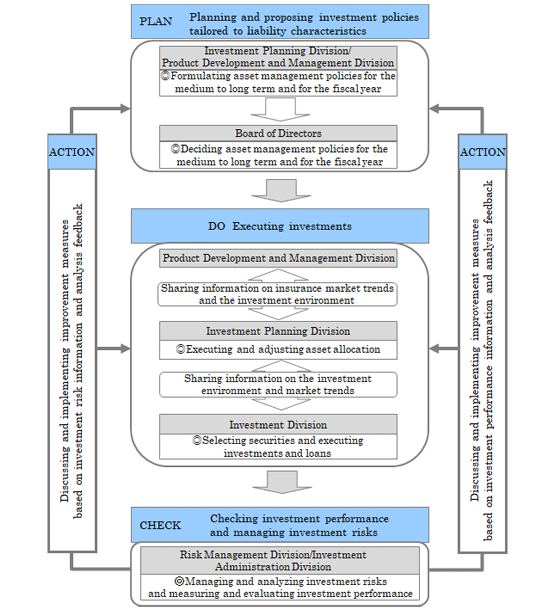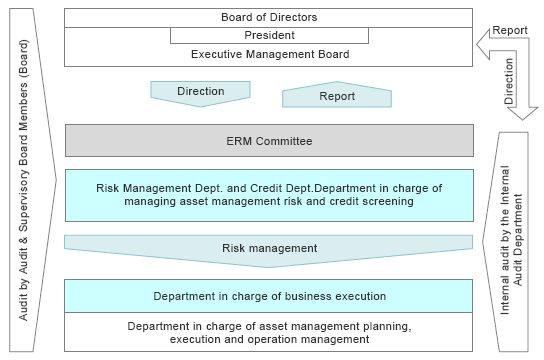- Home >
- Social Responsibility >
- Our Role as an Institutional Investor >
- Dai-ichi Life's Asset Management (General Account)
Dai-ichi Life's Asset Management (General Account)
Basic Policy on Asset Management "Expand Medium- to Long-Term Return through Rigorous Application of ALM"
Formulation of Asset Management Policy Aimed at Capturing Long-Term, Stable Return
We have formulated an asset management policy for the medium to long term designed to achieve stable return over the long term, which is required of life insurance assets. Based on the direction of the medium- to long-term asset management policy, we formulate a short-term policy as a guidance for each fiscal year so that we can respond flexibly to changes in the insurance market and the investment environment and achieve further return.
Construction of an Asset Portfolio Suited to Life Insurance Product Characteristics
Insurance products are highly individualistic, and we have set classifications by product features to ascertain detailed liability information. The result of this analysis is reflected promptly in the formulation and revision of the asset management policy and in actual asset management execution. In this way, we aim to construct an asset management portfolio more suited to the nature of products through asset and liability management (ALM).
Rigorous Management and Analysis of Investment Risk to Ensure Safety
Since safety is also a requirement for management of life insurance assets, our asset management policy is formulated in line with rigorous investment risk management standards. In addition, we conduct daily measurement and evaluation of the results of our actual investment activities and the status of assets that we hold, as well as risk monitoring.
Asset Management with consideration of the Public Nature
The life insurance business is highly public in nature, being closely involved with stability and improvement of national living standards, economic development and the achievement of a sustainable society. Therefore, in addition to profitability, safety, and liquidity, we must also consider the public aspects of asset management. As part of this, we are actively promoting responsible investment (Sustainable investment, stewardship activities).
Asset Management Policy for Fiscal 2025
Regarding the investment policy for fiscal 2025, we will continue to construct the portfolio that focuses on fixed income assets such as public and corporate bonds based on our risk-taking policy and medium- to long-term asset management policy. In addition, we will also continue risk reduction efforts to ensure financial soundness against financial market fluctuations and improve capital efficiency. And to ensure profitability and strengthen the diversification of portfolio risks, we will actively invest in selective credit investments, infrastructure bonds and loans, alternative investments and real assets.

About Asset Management
To construct our investment portfolio tailored to the characteristics of life insurance products, the Asset Management Policy is formulated by the "Investment Planning Division" and "Product Development and Management Division". The asset allocation is exercised according to this policy, and the "Investment Division" executes the selective investment opportunities with relatively higher performing returns in each asset market. And the "Risk Management Division", "Credit research Division", and "Investment Administration Division" conduct risk management and performance measurement related to asset management. Furthermore, in order to strengthen our organization, our focus is the development of our people through accumulation of expertise and skills by dispatching trainees to domestic and international financial institutions, and job rotation. In addition, we have established systems for stable management by assigning personnel based on their specialization and experience to the "Investment Planning Division", "Investment Division", "Risk Management Division", and "Investment Administration Division".

- *We have entrusted The Dai-ichi Life Holdings, Inc. with certain investment execution functions in the areas of fixed income investment, alternative investment, and structured finance, as well as some of the credit research functions related to these investments and loans, by consolidating these functions within the Group.
Our Process
Our asset management process is based on a PDCA cycle. First, the "Investment Planning Division" and "Product Development and Management Division" formulate asset management policies according to the characteristics of the liabilities, and implement asset allocation and the investments in accordance with these policy. Next, the "Risk Management Divisions" and the "Investment Administration Divisions" measure and analyze the performance and risks, and feedback these results to the "Investment Planning Division" and "Product Development and Management Division". Based on it, the "Investment Planning Division" and "Product Development and Management Division" will consider to improve asset management policy for the following year. In this cycle, the co-operation with the "Product Development and Management Division" is incorporated as an important function and factor, and designed to reflect liability information at all times while ensuring our thorough application of ALM.

Management of Investment Risk
Definition of Investment Risk
Investment risk refers to market risk (the risk of suffering a loss due to changes in the value of the assets and liabilities owned because of changes in market conditions such as interest rates, exchange rates, and share prices), credit risk (the risk of suffering a loss due to a decrease in or eradication of the value of assets because of a deterioration in the financial condition of credit recipients), and real estate investment risk (the risk of suffering a loss due to a drop in income from real estate due to changes in rent, etc. or a decrease in the value of the real estate itself).
Objective of Managing Investment Risk
The Company manages investment risk to maintain the soundness of its assets while remaining mindful of the risk-return balance over the medium to long term.
System for Managing Investment Risk
The Risk Management Department is in charge of managing investment risk. The department conducts centralized risk management of market risk, credit risk, and real estate risk for all of the our assets in coordination with departments responsible for business execution. At regular meetings of the ERM Committee, management shares information regarding each risk to form a system that contributes to decision-making. The effectiveness and appropriateness of these risk management functions are verified by the Internal Audit Department. The Board of Directors and Executive Management Board receive status reports on risk management, and use this information as a basis for making decisions. Furthermore, the Audit & Supervisory Board Members perform audits of the overall risk management of the Company, starting with the management.
◆System for Managing Asset Management Risk


